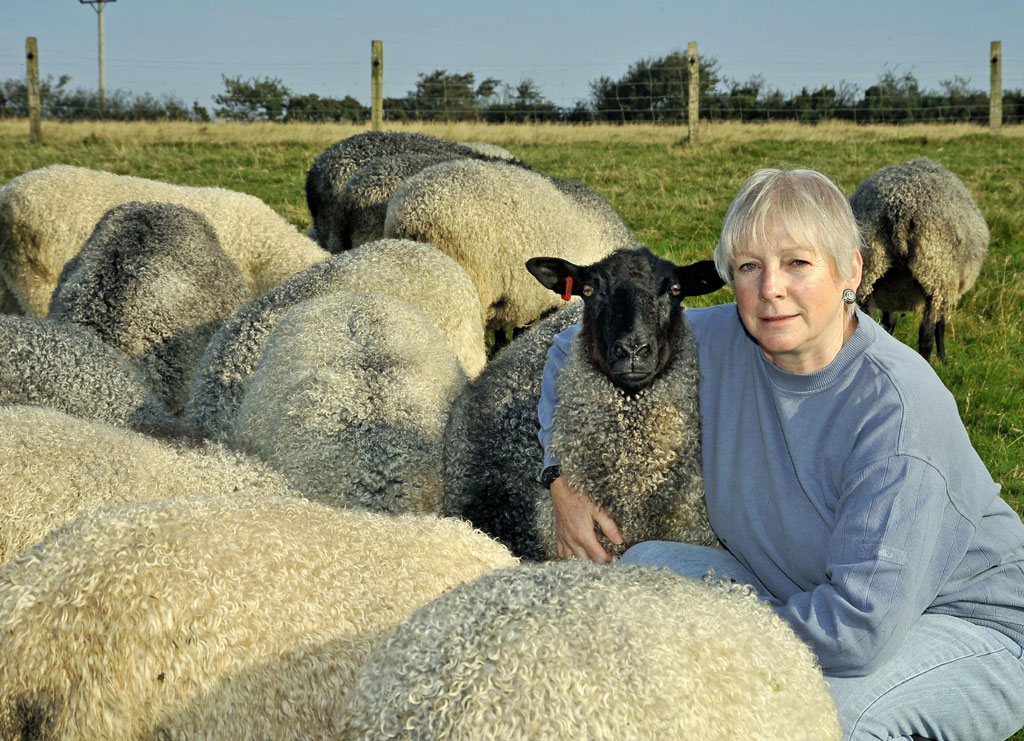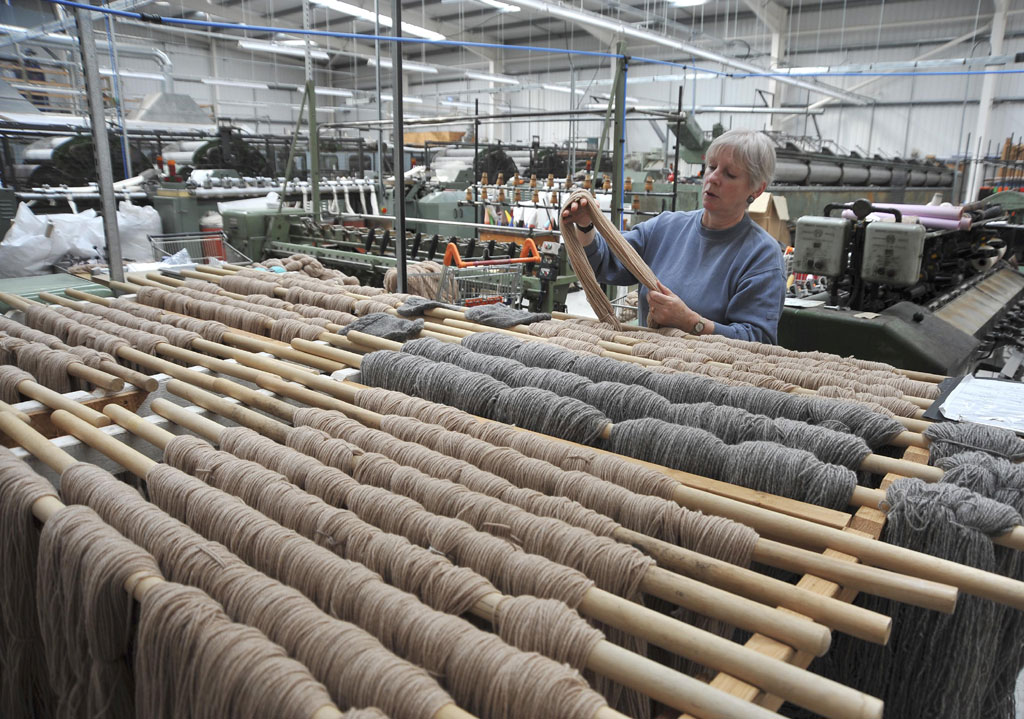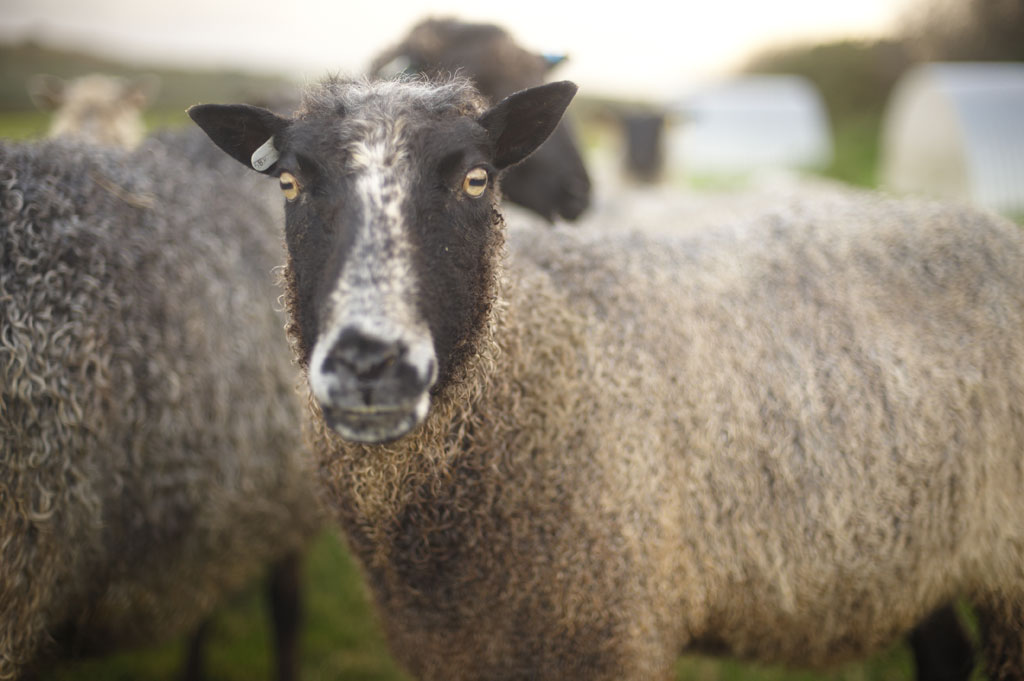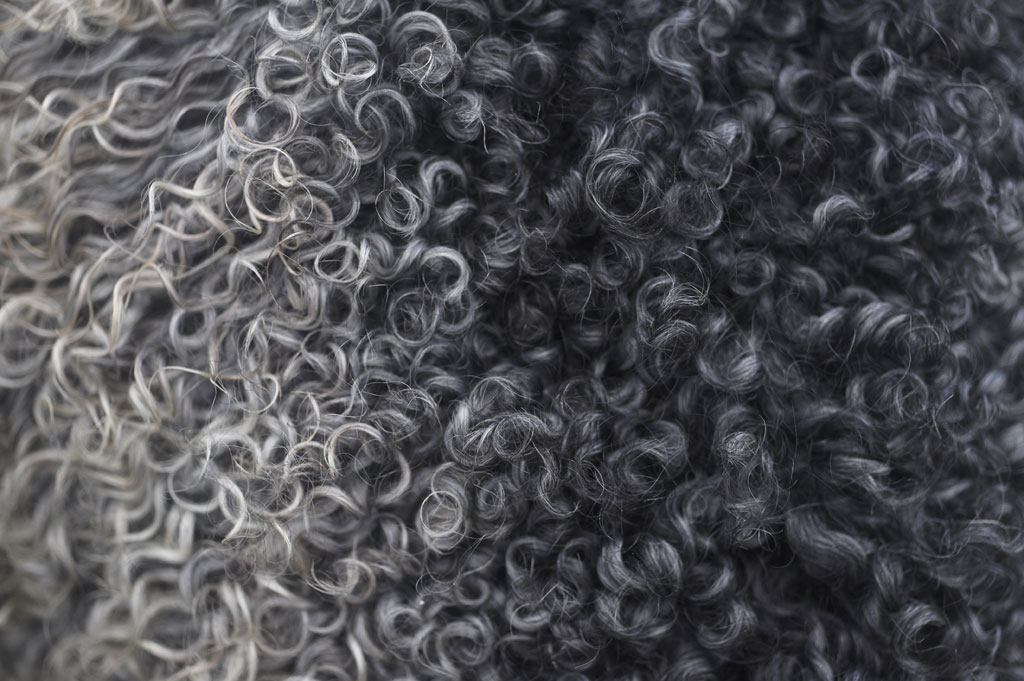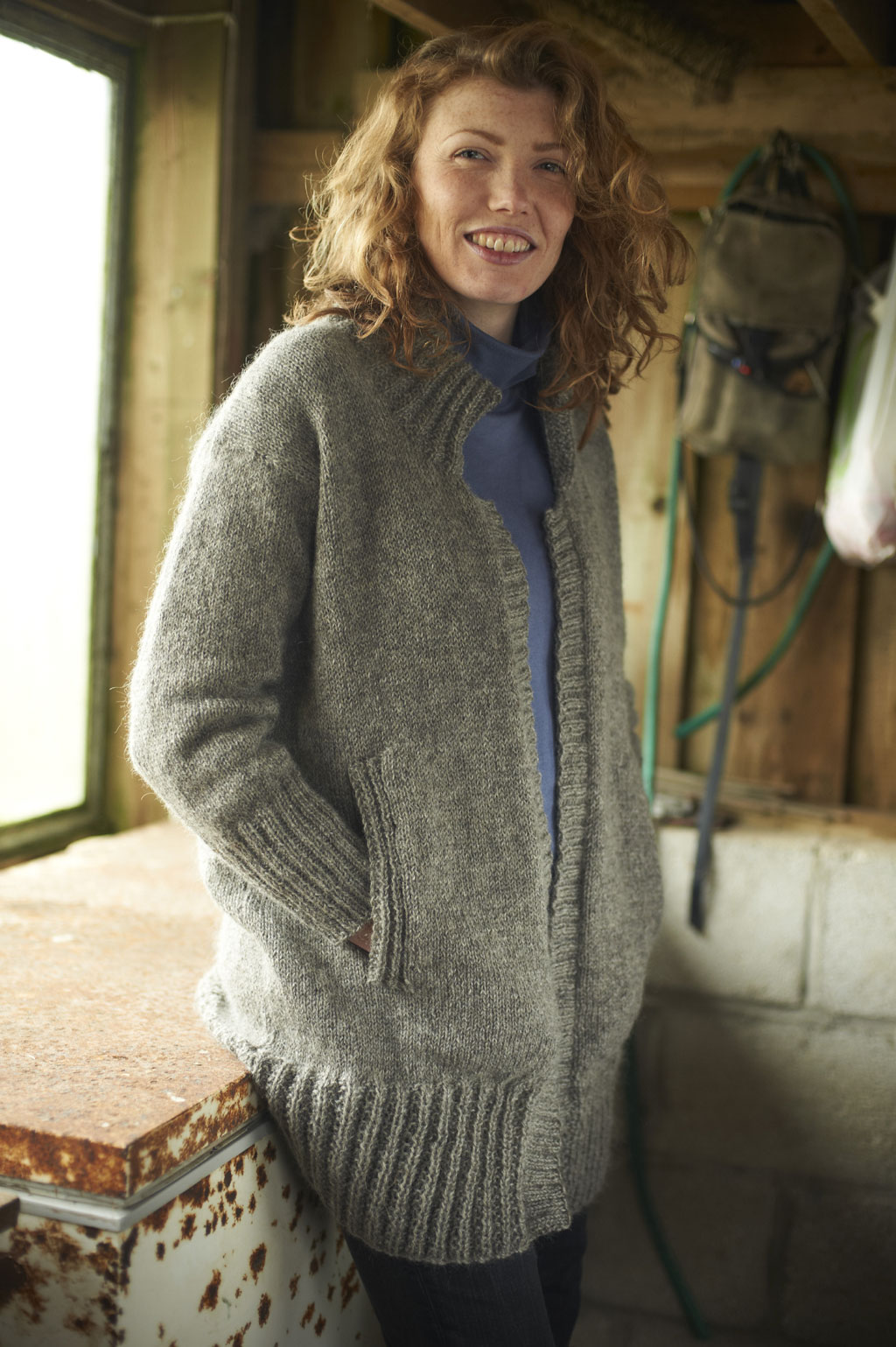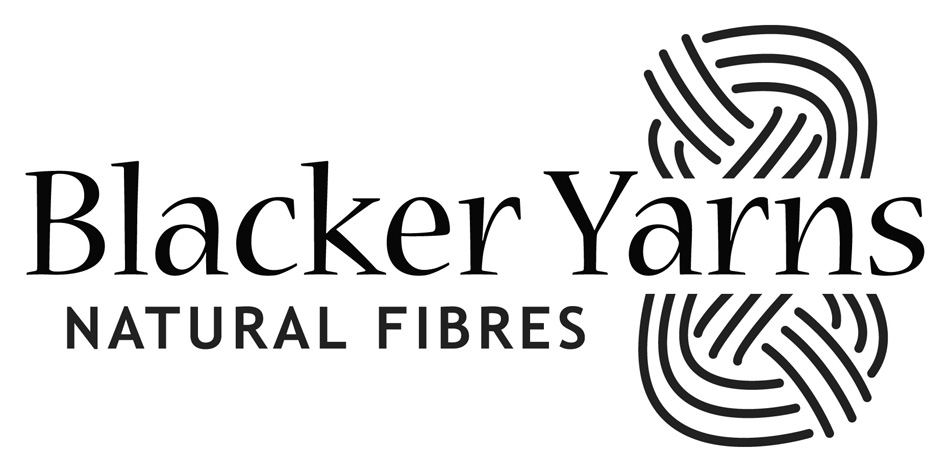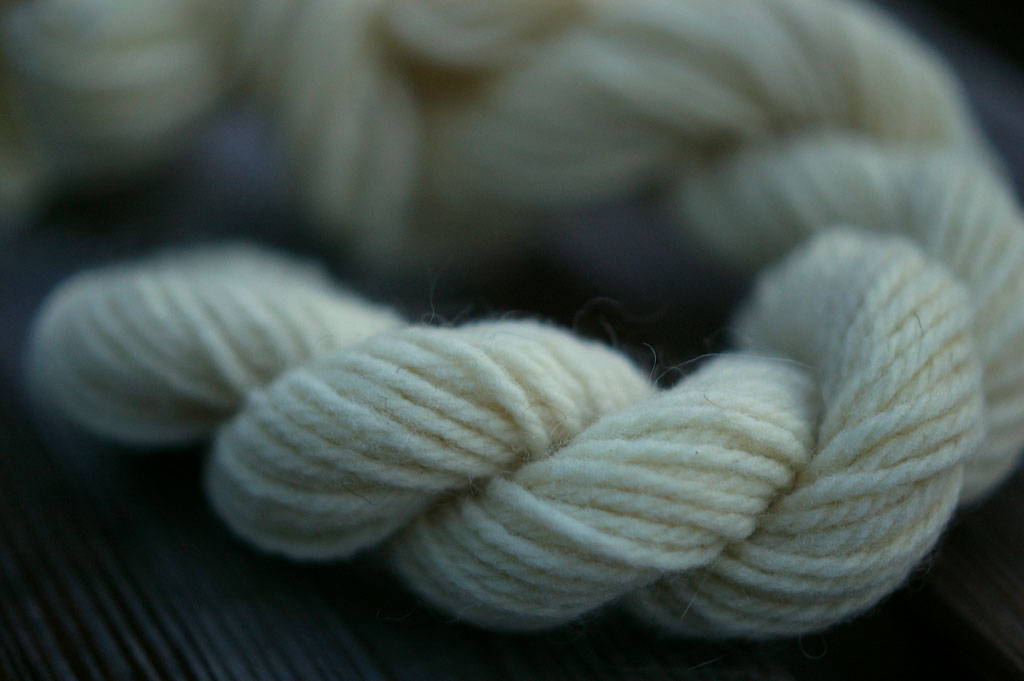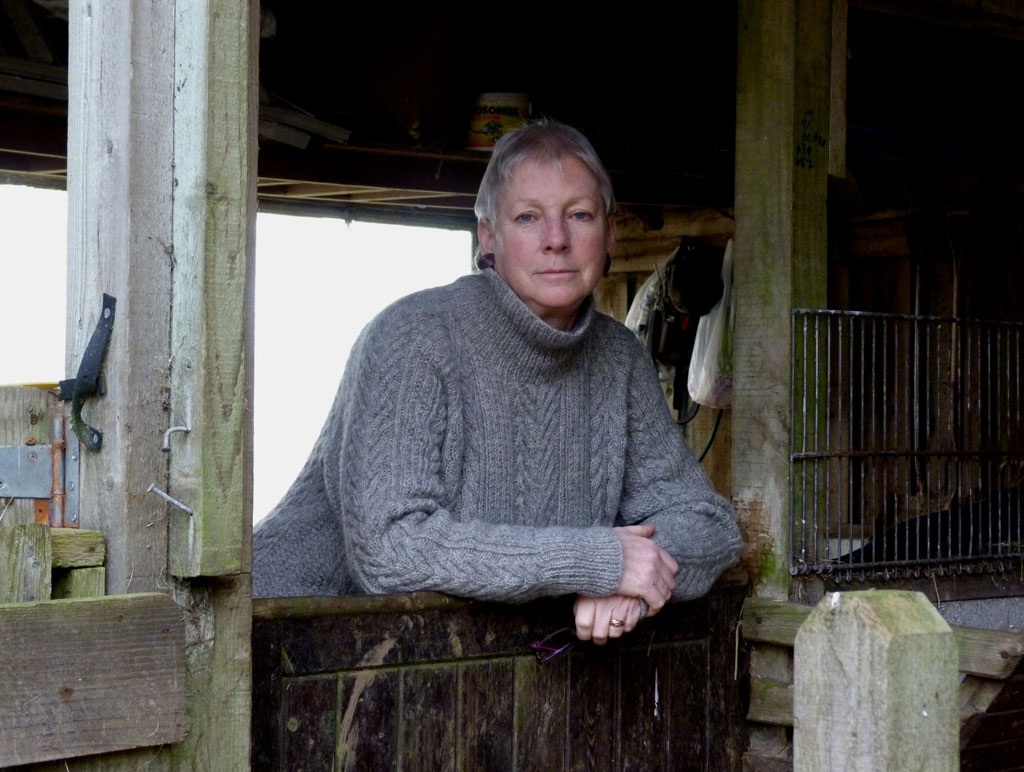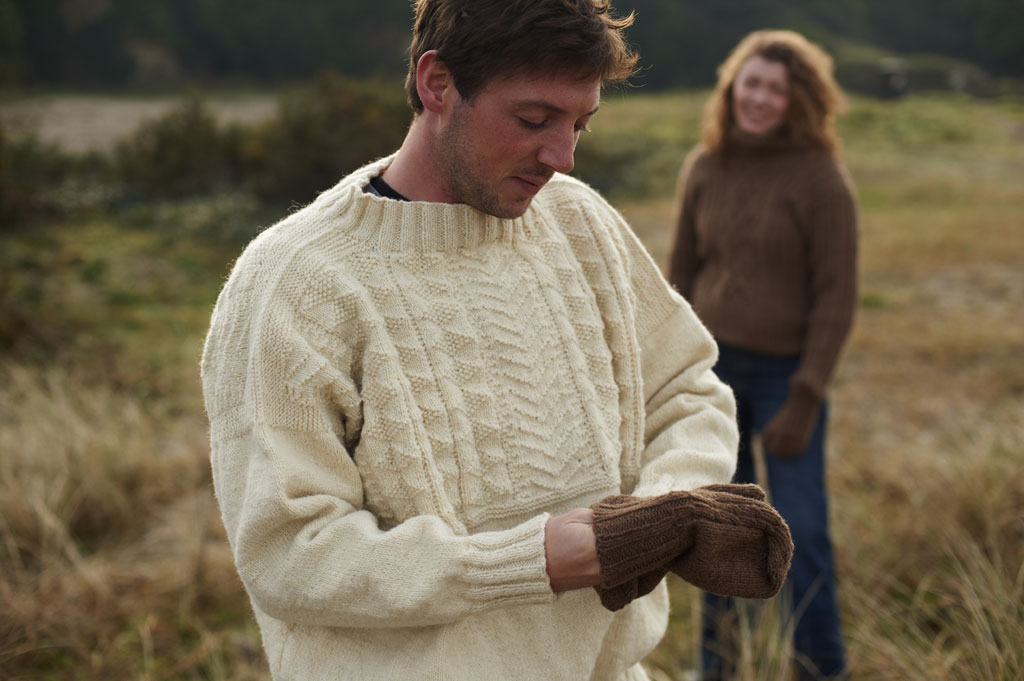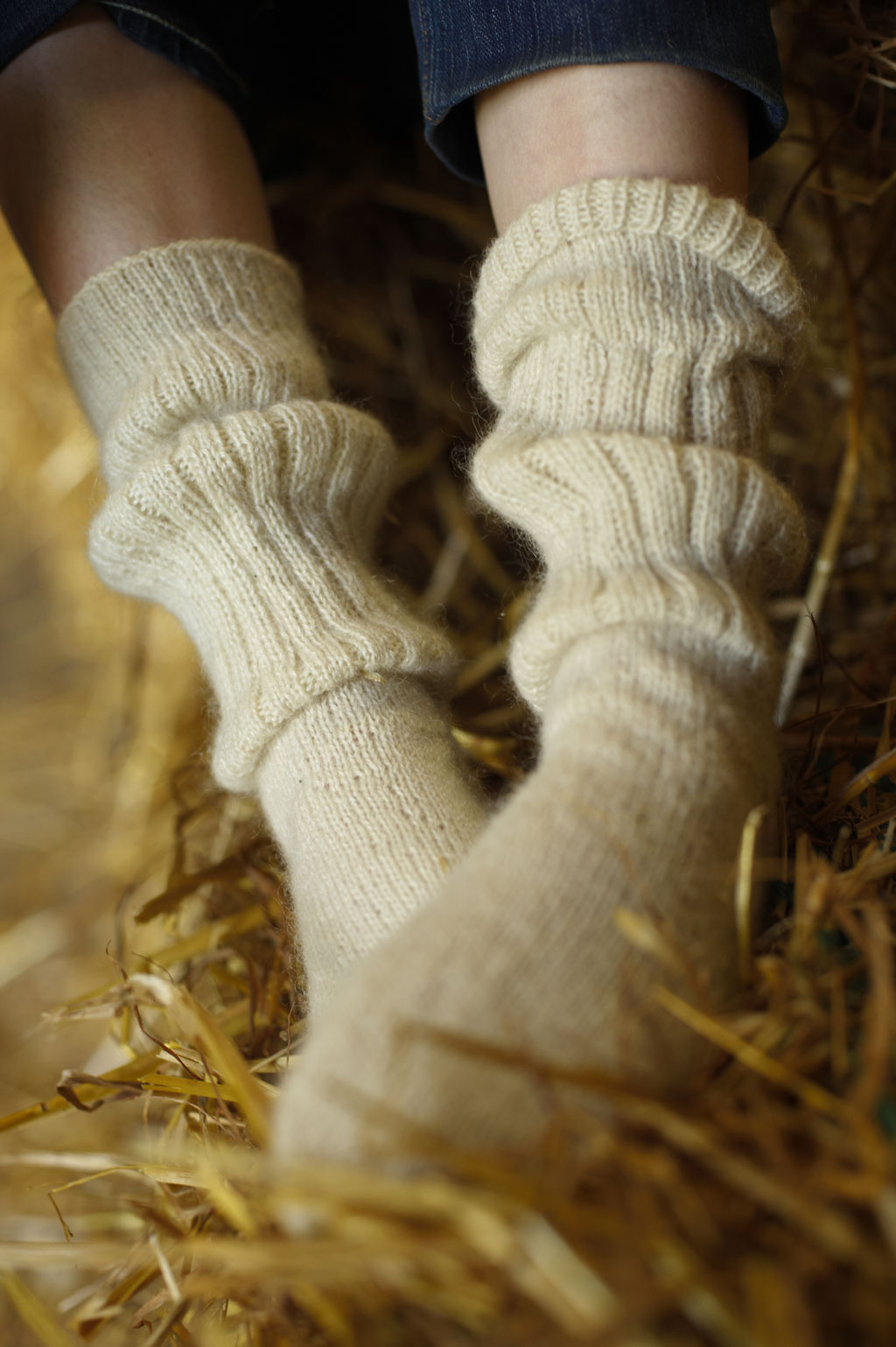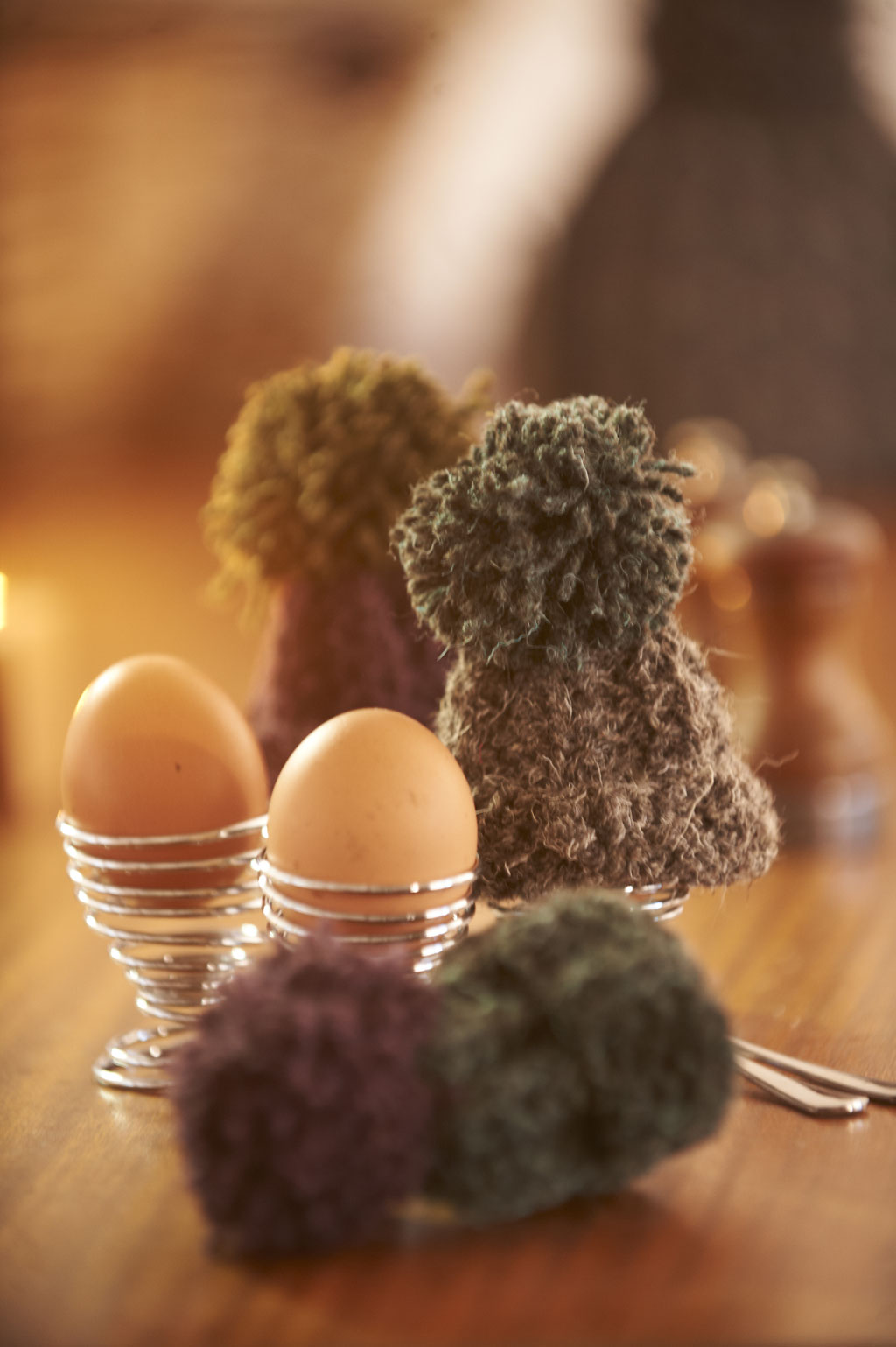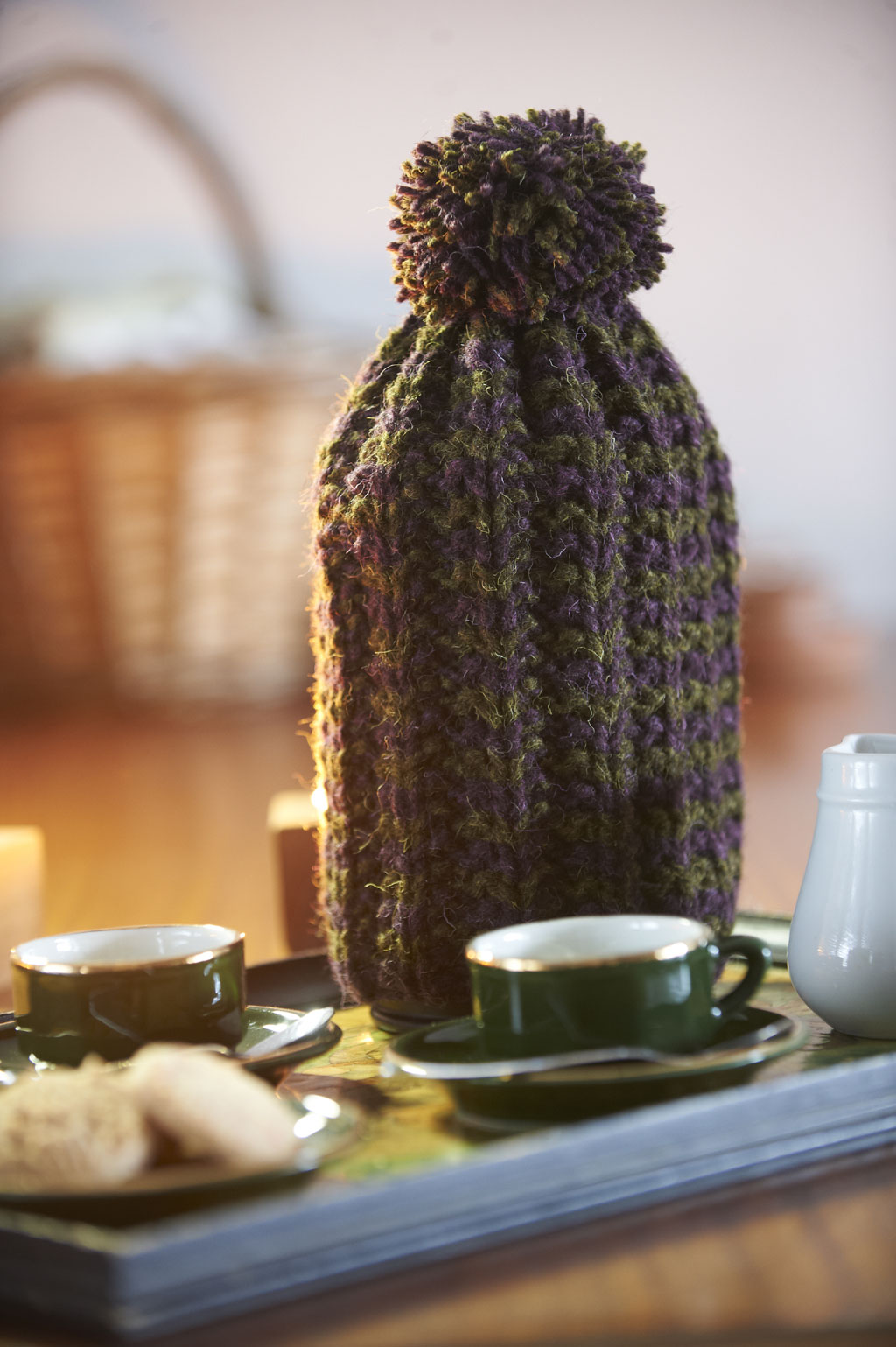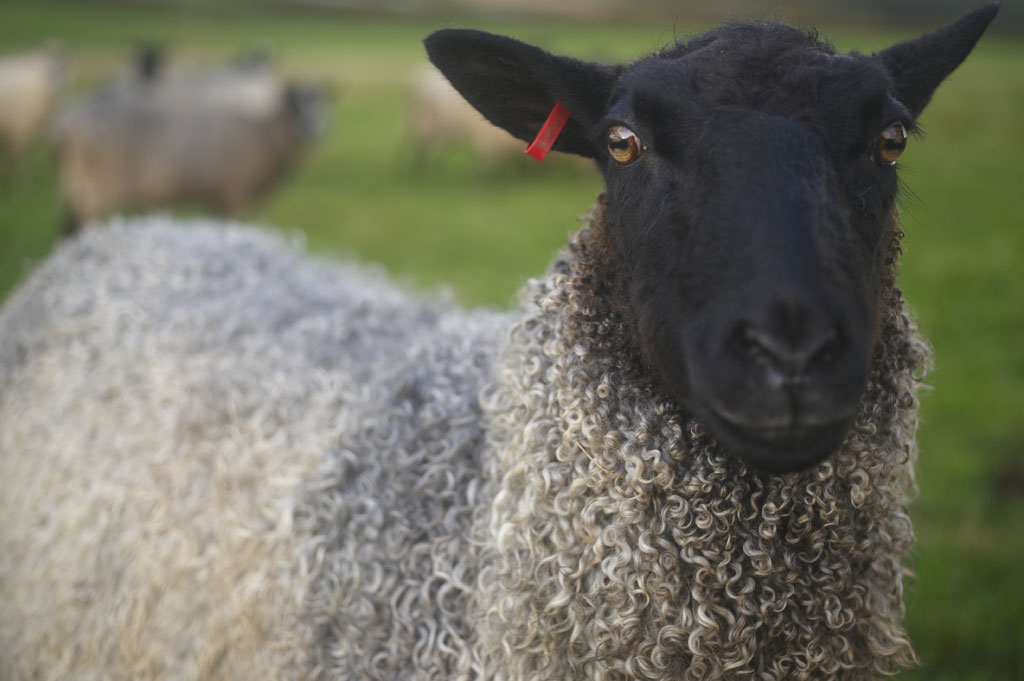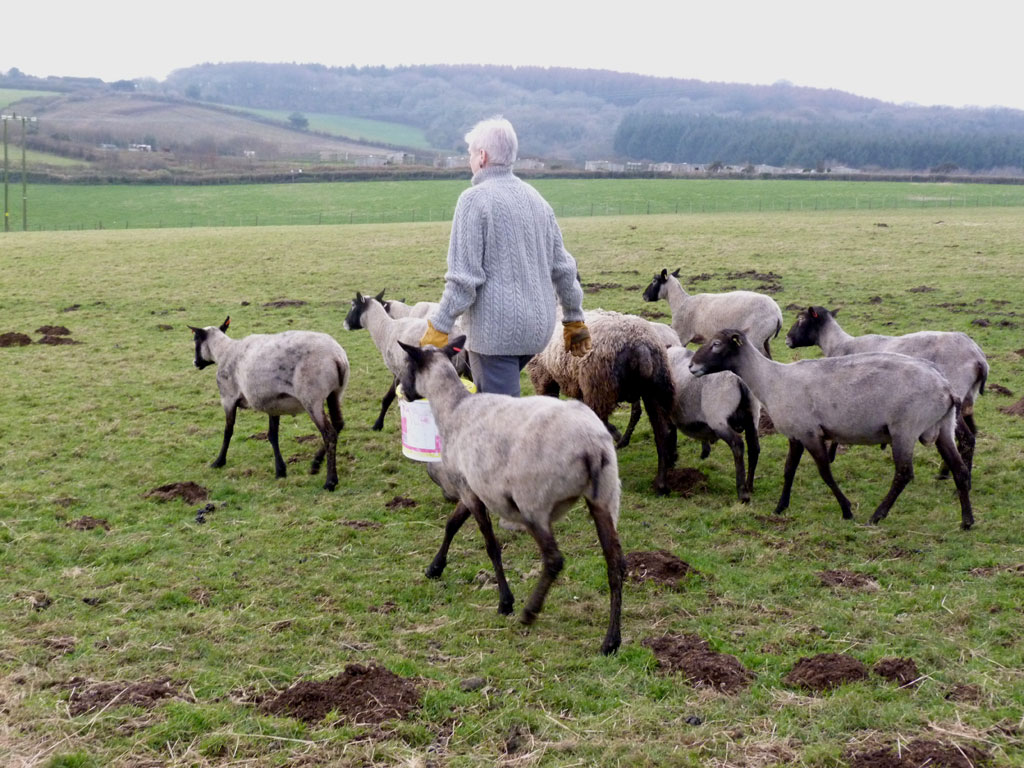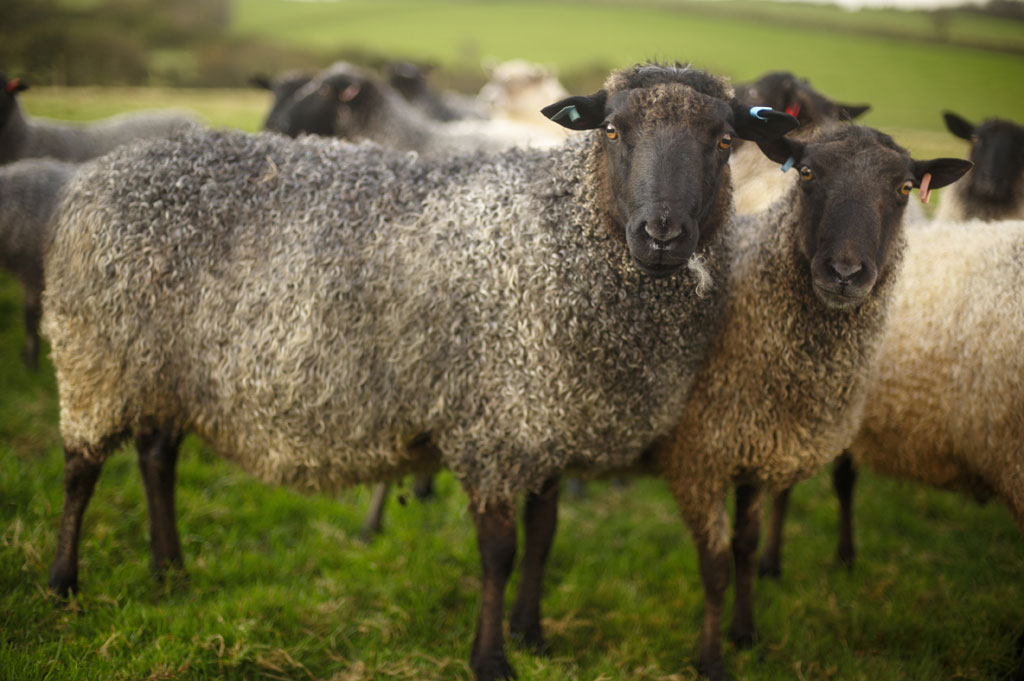Continuing on with our theme of hearing about people’s creative work with WOOL, today we shall hear from Sue Blacker about designing with the breed-specific wool that is spun at The Natural Fibre Company. At the start of WOVEMBER we explained that some of the people who would be writing here would have a hand in every stage of wool – from its beginnings on the back of a sheep, to its final use as knitting yarn, then clothes, then – eventually – as compost! Sue Blacker is one such person, and today we shall build on what we have already learnt about her sheep and her spinning business, by learning about her design work in the recently published book, Pure Wool. This book is unique in that it specifically equips the modern day knitter to select appropriate yarns for any one knitting project by delving into the qualities and character of the wool possessed by different breeds of sheep. Featuring useful descriptions of different sheep breeds and their respective yarns, Pure Wool has a gorgeously sheepy feel. Opening with a description of The Shepherd’s Year and a warm introduction from Sue Blacker herself, the book is filled with patterns which allow the characters of different sheep breeds’ yarns to be utilised to best advantage. Sue agreed to do a Q&A with WOVEMBER about her work on this book, and we present it to you here as an excellent example of, and inspiration for, Working with Wool…
1. As someone who keeps sheep, runs a spinning mill, and knits, you must have a very rich overview of woollen textile production. However I wondered if there were any patterns in Pure Wool which relate specifically to your experiences of shepherding, running a wool mill, or working with yarn as a hand knitter? What I mean is, are there areas in the book which you feel are particularly informed by your experiences in one or another of these roles you have, or is it all completely inter-related?
Sue Blacker with her sheep, photo © Douglas Bence
Sue Blacker at work in The Natural Fibre Co., photo © John Eveson
This is a very interesting question. I think part of it is definitely all inter-related. Obviously I have knowledge of much fewer sheep breeds as a shepherd as I only know two reasonably well, although I have visited loads of flocks over the years and I would certainly make different items with Gotland than with Bluefaced Leicester. However, just seeing sheep is very different to shepherding them when you begin to learn about their characters. I do feel that the ever increasing demand for soft wool is one which I would wish to resist, and also the tendency towards worsted yarns. For me a yarn must have some presence, not just softness, which is a mix of bulk, aura, drape and handle. This is not because I don’t like soft wool or worsted spun yarns – on the contrary I love both – but there’s more and less suitable yarns for each fibre and then more and less suitable patterns. The chart at the end of the book with alternative options for yarns and patterns is quite important: nothing is set in stone, but you will get a different result if you use different yarns. The patterns themselves were a mix of things which just seemed obvious and things which the publishers thought were a good idea, particularly in terms of the balance of difficulty and range of items to be made…
2. Pure Wool opens with a general “farm to yarn” section, beginning with a general introduction to the shepherd’s year, and ending with a description of how – after many stages of life, reuse and recycling – wool ultimately ends up becoming compost. This cyclical view is a kind of macrocosm of sustainable woollen textile production, but I wondered if you could take us through a specific example of a farm to yarn story in Pure Wool? I’m thinking about the long cardigan with hand-warmer pockets, knitted in Gotland fleece and designed by you and Myra Mortlock; this presumably started life on the back of your flock of sheep. Could you show us the stages of how that became a garment, and predict the future life of that cardigan?
Gotland sheep, photo © Sam Morgan Moore
Gotland fleece, photo © Sam Morgan Moore
Cardigan knit in Gotland, photo © Sam Morgan Moore
Interestingly, Myra made the original design for Jacob/mohair wool and we felt it would work well in Gotland (which has some characteristics in common with mohair, particularly the lustre). So the pattern itself has evolved! It started without sleeves, but people asked for sleeves so we added them for the book. The cable design on the back is the big attraction to most knitters. Myra designed both this cable motif and also the twisted 4-part cable we use on our free beanie and mitts from the inspiration of our original logo.
Our logo was my idea: I love knots, and the Carrick Bend is a named after part of the river mouth of the Fal River in Cornwall, The Carrick Roads. So the knot signifies a Celtic motif, a Cornish origin, and is about linking things together, as The Natural Fibre Company links sheep to yarns, farmers to added value and customers, and Wales to Cornwall (through our move). It is also slightly reminiscent, without being a copy, of the Woolmark or a twisted skein of yarn.
Twisted skein of Southdown Blacker Yarns, photo © Felicity Ford
So the design has definitely evolved and I have another version for a jacket using the Sleeveless Long Cardy cable in a different way – it’s partly written but needs some actual knitting to work out a couple of things.
I am particularly happy about another pattern actually: Sue’s Aran Sweater, which is not actually knitted in Aran-weight yarn, but in DK. The original was made with yarn a local lady bought from me and made for herself. Then her life changed for various reasons and she could not bear to put the pullover into a charity shop when she moved away. So one day she turned up and gave me the pullover as she felt I would look after it and wash it properly. This felt like an incredible honour for me. Of course, I have looked after the garment, and we then back engineered the design from the garment by working out the patterns and stitch numbers. We also adjusted it so that it is actually only a 6-row repeat, which makes it a very easy garment for a beginner. So it’s now one of our patterns.
Then we come to the yarn! My early yarns were all from my own sheep, before I bought The Natural Fibre Company and I still have some (I have been designing an updated version of a Guernsey-style tunic for around 8 years, which is the standing joke in the office). The difficult bit is that most of our stuff lasts – and is intended to last – for a very long time! So I have not got around to re-cycling much of my own stuff – I regret to say that I have and regularly wear garments which are over 10 years old!
Sue Blacker in a lovely long-lasting wool pullover, in her sheep barn, photo © Douglas Bence
I have been thinking of suggesting that people could consider the cost of our yarns as an investment, based on the number of years they will last compared to non wool yarns – so yarn years of possible use by a careful owner can justify the price. However, all of the stuffing which we made for the Woolsack cushions was in the end made from a blend of spinning waste and re-cycled yarns…
3. I love the styling of “Pure Wool”; many of the garments themselves seem immensely sensible, and the photo locations evoke life on a working farm. I am thinking particularly of the cable tunic knit in Galway yarn, the Jacob/Mohair socks for walking and welly boots, and the traditional gansey knit in Romney 5-ply Guernsey knitting yarn. How important was it to you in “Pure Wool” to present wool in a practical light, and to maintain a connection between finished knitted things and the places where wool comes from?
Guernsey pattern from Pure Wool, knit in Romney 5-ply Guernsey knitting yarn, photo © Sam Morgan Moore
Socks for walking and welly boots pattern from Pure Wool, knit in Jacob/Mohair or Jacob 4-ply, photo © Sam Morgan Moore
This is essential, but also a function of what we can afford! We are lucky in that Sam Morgan Moore our photographer – who started with us right at the beginning of the Blacker Designs and Yarns project – understands what we are trying to do and is able to make it into pictures (with his very expensive camera and computer). The locations are all very close to home and we deliberately choose models who look as natural as possible. We only colour correct and crop our pictures – there is no re-touching or air-brushing. This is quite a challenge for Sam sometimes as the light and weather never seem quite perfect – too sunny or too dark! The paper used for the book has helped with this, although the downside is that the detail is lost on some of the darker yarns, which tend to eat the light anyway. We photograph all our balls and swatches in a studio but pretty much everything else is done with natural light, either shaded or reflected sometimes, and with the camera hand-held. The Galway and Romney were photographed at a local beach on the same day while a lot of the stuff was done at my farm yard (mainly because there was some shelter from the utterly horrible rain that day).
4. “Pure Wool” gives a lot of guidance to knitters who are interested in knitting with breed-specific yarns, but I wondered what are some of the challenges which Blacker Yarns faces in terms of marketing breed-specific yarns to the public, and what are some of the advantages to knitting with breed-specific yarns which you don’t get when wool is all mixed together and sold simply as “100% Pure Wool?”
Where to start? Read the book! You can sometimes read between the lines to perceive some of the challenges. Gotland, Cotswold and Herdwick are more difficult to spin than some other fibres. Some fibres are popular because they have a great name as well as being nice and I would rank Black Welsh Mountain and Bluefaced Leicester amongst these, but the general public goes for softness and colour and cares less about British, pure breed or even pure wool. Some breeds are challenging because even though they are interesting, they may not make a wonderful yarn – we have often blended Castlemilk Moorit for this reason, although we are about to make some pure as we have found a good source of fibre. We are lucky in that our work has encouraged farmers to improve their fleeces, which is making our job easier and because we are able to select from amongst the best – we could not make large quantities of North Ronaldsay or Boreray simply because there aren’t enough sheep! In order to cater for higher volumes we have created our Blacker Classic and Blacker Swan ranges which we make from wool from named farms. The big thing for me is creating the links between the land and the wool and the person who wears it. Blends of specific breeds for specific purposes, like Manx/Hebridean, can improve both. We made a blend of Alpaca and Shetland which was lovely but neither Shetland nor Alpaca enthusiasts seemed dead keen and it took a while to sell – now people are asking for more because it was actually an excellent yarn! Sometimes we just have to wait until people have experienced the yarns as they are all an acquired taste and people also have to get used to the fact that every batch and colour will vary much more than one might expect, from year to year, flock to flock, and even within the same flock.
5. I would have loved to have been a fly on the wall while “Pure Wool” was being discussed by you and the other knitters who developed all the patterns! I particularly like the Hebridean handbag, using Hebridean wool – “A good dark off-black, strong”; the Herdwick tea, cafetiere, and egg cosies,very white, soft, bulky using Herdwick wool – “coarse, kempy but great heathered colours”; and the Corriedale hot-water bottle cover, using Corriedale wool – “very white, soft, bulky, versatile”. I wondered if you could say briefly why you chose these particular breeds for these projects.
The Hebridean bag just started with a name the publisher likes “Big Black Bag”, although in the end they did not use it (!) and is a development of one of our existing patterns, which I designed. The knitter and I had to have several goes to get the curve of the slouchy bag right but I’m very pleased with it now and think I like it the best of the three versions. The curved version is new for the book and the other two have been around longer.
Egg cosy pattern from Pure Wool, knit in Herdwick Aran yarn, photo © Sam Morgan Moore
Herdwick is ideal for the egg-cosies. You may have noticed that actually the rib used for them and the hot-water bottle cover is the same? It’s used for the same reason in both projects, as with woollen-spun yarn and this rib you get loads of air trapped, so the insulation is more effective, which is part of the purpose of these items. But cosies don’t touch the skin and the hot-water bottle cover does, so this was not a particularly challenging choice! Herdwick will also stand a few tea and coffee stains without showing, but the Corriedale only has to go to bed with you and would not like tea or coffee. So again the colour of the fibre worked with the design.
Cafe press cosy pattern from Pure Wool, knit in Herdwick Aran yarn, photo © Sam Morgan Moore
6. Finally, I really enjoyed your comments in the introduction to Pure Wool regarding the intelligence of sheep. I wondered if you had always thought sheep were intelligent, or if there was a particular moment during your experiences of keeping Gotlands when you realised this.
Hmmm! Actually before I had sheep I shared the common perception that they are stupid. I also was not particularly fond of the sheep and goat eyes with the pupils as vertical bars. Somehow Gotland eyes are just wonderful though!
Gotland stare, photo © Sam Morgan Moore
There is actually a reasonable amount of scientific research on sheep intelligence/memory, etc. (you can probably find it!) – they can recognise around 400 faces (mostly of other sheep) and clearly have colour preferences, as well as being well able to remember places (e.g. hefting in Cumbria) and they are capable of self medicating and choosing carefully amongst the plants they eat. Their main concern is survival from predators and the flocking or scattering instincts are very important for this – they have very little ability to deal with attacks, so it’s the weakest which is the victim… they are probably the most sensitive animals I know to mood or weather and respond accordingly.
However when we were researching what to have to keep the grass under control at our holiday cottages it was obvious that sheep were the right answer – good for pasture, small enough to manage without large equipment and buildings, etc. Gotlands are what you get when you ask a hand spinner and Gotland owner which sheep is a good one to have! I have written elsewhere about the importance of choosing a sheep breed and it is certainly the case that my Gotlands and Bluefaced Leicesters are different from each other.
Sue with her sheep, photo © Douglas Bence
The primitive breeds are more instinctive and cunning than others in my experience. But sheep are like all animals around humans: you get what you deserve! Recently I took some kids from a large farm to see my sheep and the smallest one was alarmed because the sheep at his farm run away rather than coming up to inspect you. He seemed to get used to it quite quickly, though…
The best moment is the one I mention in the book where I watched Jake spend half an hour trying to break into the hen-house – this is a reasonable amount of time to concentrate on a project for a person, never mind a sheep – and he was working on the catch, not anything else. The other is when the sheep learnt that electric fences are for wimps – they watched us with the fence and visibly winced when we went up to it but were then amazed that we seemed able to manage (we turned it off of course), so after a while they just charged them down. Some sheep do seem to obey electric fences but Gotlands know them for a tricky and ineffectual human device which will not stop a determined and purposeful sheep from getting where he or she wants to go…
Clever Gotlands! Photo © Sam Morgan Moore
All content in this post – unless otherwise stated – is copyright Sue Blacker, Blacker Yarns, and The Natural Fibre Company, and used with their kind permission. Pure Wool is available to buy directly from The Natural Fibre Company here
